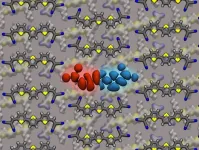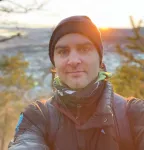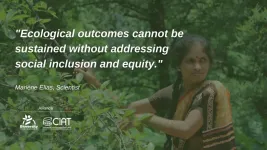(Press-News.org) The 30,000 or so genes making up the human genome contain the instructions vital to life. Yet each of our cells expresses only a subset of these genes in their daily functioning. The difference between a heart cell and a liver cell, for example, is determined by which genes are expressed--and the correct expression of genes can mean the difference between health and disease.
Until recently, researchers investigating the genes underlying disease have been limited because traditional imaging techniques only allow for the study of a handful of genes at a time.
A new technique developed by Jun Hee Lee, Ph.D., and his team at the University of Michigan Medical School, part of Michigan Medicine, uses high-throughput sequencing, instead of a microscope, to obtain ultra-high-resolution images of gene expression from a tissue slide. The technology, which they call Seq-Scope, enables a researcher to see every gene expressed, as well single cells and structures within those cells, at incredibly high resolution: 0.6 micrometers or 66 times smaller than a human hair--beating current methods by multiple orders of magnitude.
"Whenever a pathologist gets a tissue sample, they stain it and look at it under the microscope--it's how they diagnose disease," explained Lee, an associate professor in the Department of Molecular & Integrative Physiology. "Instead of doing that, with our new method, we have made a microdevice that you can overlay with a tissue sample and sequence everything within it with a barcode with spatial coordinates."
Each so-called barcode is made up of a nucleotide sequence--the pattern of A, T, G, an C--found in DNA. Using these barcodes, a computer is able to locate every gene within a tissue sample, creating a Google-like database of all of the mRNAs transcribed from the genome.
"People have been trying to do this with other methods, such as microprinting, microbeads or microfluidic devices, but because of technological limitations, their resolution has been a distance of 20-100 micrometers. At that resolution you can't really see the level of detail needed to diagnose diseases," Lee said.
Lee adds that the technology has the potential to create an unbiased systematic way to analyze genes.
"Whenever we do science, we had to make a hypothesis about the role of two or three genes, but now we have genome-wide data at the microscopic scale and much more knowledge about what's going on inside that patient or model animal's tissue."
This knowledge could be used to provide insight into why certain patients respond to certain drugs while others do not, said Lee.
The team demonstrated the effectiveness of the technique using normal and diseased liver cells, successfully identifying dying liver cells, their surrounding inflamed immune cells and liver cells with altered gene expression.
"This technology actually showed many known pathological features that people have previously discovered but also many genes that are regulated in a novel way that was unrecognized previously," said Lee. "Seq-Scope technology, combined with other single cell RNA sequencing techniques, could accelerate scientific discoveries and might lead to a new paradigm in molecular diagnosis."
INFORMATION:
The work is described in the latest issue of the journal Cell.
Additional authors include: Chun-Seok Cho, Jingyue Xi, Yichen Si, Sung-Rye Park, Jer-En Hsu, Myungjin Kim, Goo Jun and Hyun Min Kang.
This work was supported by the NIH (T32AG000114 to C.S.C., K01AG061236 to M.K,U01HL137182 to H.M.K., J.X. and Y.S, R01DK118631 and R03HD098552 to G.J., R01DK114131 and R01DK102850 to J.H.L., P30AG024824, P30DK034933, P30DK089503, P30CA046592, P30AR069620, and U2CDK110768), Chan Zuckerberg Initiative (to H.M.K.), Frankel Cardiovascular Center Inaugural grant (to J.H.L. and M.K.), American Association for the Study of Liver Diseases (to J.H.L. and H.M.K.), Mcubed (to M.K., H.M.K. and J.H.L.), Glenn Foundation (to J.H.L.), Taiwan Government Scholarship (to J.E.H.) and ADVANCE and MTRAC awards (to J.H.L.), funded by the Michigan Economic Development Corporation.
Declarations: Jun Hee Lee is an inventor on pending patent applications related to Seq-Scope.
Paper cited: "Microscopic Examination of Spatial Transcriptome Using Seq-Scope," Cell. DOI: 10.1016/j.cell.2021.05.010
A study published in the June 10, 2021 issue of Cell describes a remarkable new mechanism by which the body's own immune system can eliminate cancer cells without damaging host cells. The findings have the potential to develop first-in-class medicines that are designed to be selective for cancer cells and non-toxic to normal cells and tissues. If successful, this discovery may improve the practice of precision medicine by ensuring the right drug is delivered at the right dose at the right time.
Our immune system plays a critical role in our ability to fight off diseases ...
Organic semiconductors have earned a reputation as energy efficient materials in organic light emitting diodes (OLEDs) that are employed in large area displays. In these and in other applications, such as solar cells, a key parameter is the energy gap between electronic states. It determines the wavelength of the light that is emitted or absorbed. The continuous adjustability of this energy gap is desirable. Indeed, for inorganic materials an appropriate method already exists - the so-called blending. It is based on engineering the band gap by substituting atoms in the material. This allows for a continuous tunability as, for example in aluminum gallium arsenide semiconductors. Unfortunately, this is not transferable to organic semiconductors ...
Leipzig. Soot particles from oil and wood heating systems as well as road traffic can pollute the air in Europe on a much larger scale than previously assumed. This is what researchers from the Leibniz Institute for Tropospheric Research (TROPOS) conclude from a measurement campaign in the Thuringian Forest in Germany. The evaluation of the sources showed that about half of the soot particles came from the surrounding area and the other half from long distances. From the researchers' point of view, this underlines the need to further reduce emissions of soot that ...
It is generally agreed that sperms "swim" by beating or rotating their soft tails. However, a research team led by scientists from City University of Hong Kong (CityU) has discovered that ray sperms move by rotating both the tail and the head. The team further investigated the motion pattern and demonstrated it with a robot. Their study has expanded the knowledge on the microorganisms' motion and provided inspiration for robot engineering design.
The research is co-led by Dr Shen Yajing, Associate Professor from CityU's Department of Biomedical Engineering (BME), and Dr Shi Jiahai, Assistant Professor of the Department of Biomedical Sciences (BMS). Their findings have been published in ...
An electrode coating just one molecule thick can significantly enhance the performance of an organic photovoltaic cell, KAUST researchers have found. The coating outperforms the leading material currently used for this task and may pave the way for improvements in other devices that rely on organic molecules, such as light-emitting diodes and photodetectors.
Unlike the most common photovoltaic cells that use crystalline silicon to harvest light, organic photovoltaic cells (OPVs) rely on a light-absorbing layer of carbon-based molecules. Although OPVs cannot yet rival the performance of silicon cells, they could be easier and cheaper to manufacture at a very large scale using ...
The type of material present under glaciers has a big impact on how fast they slide towards the ocean. Scientists face a challenging task to acquire data of this under-ice landscape, let alone how to represent it accurately in models of future sea-level rise.
"Choosing the wrong equations for the under-ice landscape can have the same effect on the predicted contribution to sea-level rise as a warming of several degrees", says Henning Åkesson, who led a new published study on Petermann Glacier in Greenland.
Glaciers and ice sheets around the world currently lose more than 700,000 Olympic swimming pools of water every day. Glaciers form by the transformation of snow into ice, which is later melted by ...
With the start of the United Nations' Decade on Ecosystem Restoration, which runs through 2030, a tremendous amount of money and effort will be put into re-growing forests, making over-exploited farmland productive, and reviving damaged marine environments. This is a good, and vital, initiative. Without quick action to clean up the fallout of humanity's scorched-earth economic systems, goals on hunger, biodiversity and climate will be unattainable.
But in examining restoration projects already underway across the globe, a group of scientists has found that restoration action is at risk of failure if it doesn't make ...
Palaeoclimatologists study climate of the geological past. Using an innovative technique, new research by an international research team led by Niels de Winter (VUB-AMGC & Utrecht University) shows for the first time that dinosaurs had to deal with greater seasonal differences than previously thought.
De Winter: "We used to think that when the climate warmed like it did in the Cretaceous period, the time of the dinosaurs, the difference between the seasons would decrease, much like the present-day tropics experience less temperature difference between ...
Inaccessible workplaces, normative departmental cultures and 'ableist' academic systems have all contributed to the continued underrepresentation and exclusion of disabled researchers in the Geosciences, according to an article published today (Thursday 8 June) in Nature Geosciences.
The article argues that changes to both working spaces and attitudes are urgently needed if institutions are to attract, safeguard and retain people with disabilities.
Anya Lawrence, a disabled early career researcher in the University of Birmingham's School of Geography, Earth and Environmental Science and author of the piece says:
"Disabled geoscientists like myself face barrier after barrier on a daily ...
People who smoke, suffer from high blood pressure, obesity, or diabetes are not only at greater risk of suffering a stroke, heart attack, or dementia. For them, the risk of being affected by depressive mood or depression also increases. The more risk factors a person has, the more likely this is. Until now, however, it was unclear whether this probability also depends on their age. Earlier studies had already shown for other diseases such as dementia or stroke that a combination of several risk factors leads to a more frequent onset of the disease between the ages of 40 and 65 than in old age. Until now, however, it was unclear whether this also applies to depression.
Researchers ...




